Tsuba of oval form decorated with vines, tendrils, and leaves on trellis in brass inlay with details carved in kebori, and pierced with six family crests (mon) with two, three and four pointing stars in openwork, each outlined with brass wire and carved in kebori. Original hitsu-ana outlined with brass wire was probably enlarged later. Copper sekigane.
Momoyama to early Edo period (end of the 16th - beginning of the 17th century). Dimensions: 68.3 x 64.5 x 3.4 mm.-

-
 Iron tsuba of 14-petal chrysanthemoid form (kikka-gata) with alternating solid and openwork petals, the latter outlined with brass wire (sen-zōgan) and the former decorated with brass dots (ten-zōgan), on both sides. Seppa-dai is outlined with brass wire. Small hitsu-ana probably cut later. Late Muromachi period (Ca. 1514-1573). Ōnin school. Unsigned. Dimensions: 87.0 x 87.8 x 3.2 mm. Similar tsuba in this collection: TSU-0420.2022
Iron tsuba of 14-petal chrysanthemoid form (kikka-gata) with alternating solid and openwork petals, the latter outlined with brass wire (sen-zōgan) and the former decorated with brass dots (ten-zōgan), on both sides. Seppa-dai is outlined with brass wire. Small hitsu-ana probably cut later. Late Muromachi period (Ca. 1514-1573). Ōnin school. Unsigned. Dimensions: 87.0 x 87.8 x 3.2 mm. Similar tsuba in this collection: TSU-0420.2022 Other similar specimens can be found at:
Henri L. Joly and Kumasaku Tomita, Japanese art and handicraft, "Swords and sword fittings" section, sub-section “Inlays of Ōnin, Kyoto, Fushimi-Yoshiro, and Kaga Province”, Plate CX, #128: Iron, chrysanthemoid, thin guard with alternate petals covered with brass spots. Ōnin style. 16th century.
Compton Collection, Part I, #7: The iron plate is of flowerhead shape with each of the fourteen petals alternating between solid and openwork. The apertures are outlined in inlaid brass as is the seppa-dai and hitsu-ana. The remainder of the plate is similarly inlaid with plum flowers, birds, dots of dew, Genji mon and sambiki mon. 87 mm x 85 mm x 3.5 mm.
Other similar specimens can be found at:
Henri L. Joly and Kumasaku Tomita, Japanese art and handicraft, "Swords and sword fittings" section, sub-section “Inlays of Ōnin, Kyoto, Fushimi-Yoshiro, and Kaga Province”, Plate CX, #128: Iron, chrysanthemoid, thin guard with alternate petals covered with brass spots. Ōnin style. 16th century.
Compton Collection, Part I, #7: The iron plate is of flowerhead shape with each of the fourteen petals alternating between solid and openwork. The apertures are outlined in inlaid brass as is the seppa-dai and hitsu-ana. The remainder of the plate is similarly inlaid with plum flowers, birds, dots of dew, Genji mon and sambiki mon. 87 mm x 85 mm x 3.5 mm.
Japanese art and handicraft, Plate CX, #128.
And at Jim Gilbert website: Onin ten zogan tsuba, mid Muromachi. Size: 7.7 cm T x 7.6 cm W x 0.3 cm. Iron plate with brass inlay. Kiku gata. The Ōnin ten zogan style is characterized by the decoration of small brass “nail heads” and wires on a thin iron plate. The iron often has a soft, granular texture and seems to be prone to rust. Unfortunately, this rust will undermine the brass inlay and result in the loss of some of the inlay. This example is in reasonably good but far from perfect condition. As is often the case, the backside is better preserved, with the wire around the seppa-dai and kozuka-ana, and all petals still intact.
Compton Collection, Part I, #7.
-
 Iron tsuba of round form decorated with dragonfly (tombo) and comma (comma-like swirl, tomoe) in openwork (sukashi) outlined with brass wire. The plate decorated with 5 concentric circular rows of brass dots in ten-zōgan. Center of the plate outlined with the inlaid circular brass wire (sen-zōgan). Ōnin school. Unsigned. Mid Muromachi period, middle of the 15th century. Dimensions: Diameter: 89.5 mm, thickness: 3.1 mm. Notes regarding design: "According to various sources, the dragonfly (tombo) is emblematic of martial success, as various names for the insect are homophones for words meaning "victory". The dragonfly is also auspicious because references in the Kojiki and Nihongi link it in both name and shape to the old kingdom of Yamato." [Merrily Baird. Symbols of Japan. Thematic motifs in art and design. Rizzoli international publications, Inc., 2001, p. 108]. "The dragonfly (tonbo), was also called kachimushi in earlier times, and due to the auspicious literal meaning "victory bug" of the characters of this word it became a popular theme on sword fittings." [Iron tsuba. The works of the exhibition "Kurogane no hana", The Japanese Sword Museum, 2014, p. 13]. Helen C. Gunsaulus' description of the dragonfly emblem is as follows: "This motive, the dragon-fly (akitsu), is generally accepted as a symbol of the kingdom of Japan, and the origin of the idea is traced to the legend recounted in the Kojiki and Nihongo of the Emperor Jimmu's view of the island from mountain top. He is said to have thought the kingdom looked like a dragon-fly touching its tail with its mouth. From this it received its name Akitsu-shima... etc."
Iron tsuba of round form decorated with dragonfly (tombo) and comma (comma-like swirl, tomoe) in openwork (sukashi) outlined with brass wire. The plate decorated with 5 concentric circular rows of brass dots in ten-zōgan. Center of the plate outlined with the inlaid circular brass wire (sen-zōgan). Ōnin school. Unsigned. Mid Muromachi period, middle of the 15th century. Dimensions: Diameter: 89.5 mm, thickness: 3.1 mm. Notes regarding design: "According to various sources, the dragonfly (tombo) is emblematic of martial success, as various names for the insect are homophones for words meaning "victory". The dragonfly is also auspicious because references in the Kojiki and Nihongi link it in both name and shape to the old kingdom of Yamato." [Merrily Baird. Symbols of Japan. Thematic motifs in art and design. Rizzoli international publications, Inc., 2001, p. 108]. "The dragonfly (tonbo), was also called kachimushi in earlier times, and due to the auspicious literal meaning "victory bug" of the characters of this word it became a popular theme on sword fittings." [Iron tsuba. The works of the exhibition "Kurogane no hana", The Japanese Sword Museum, 2014, p. 13]. Helen C. Gunsaulus' description of the dragonfly emblem is as follows: "This motive, the dragon-fly (akitsu), is generally accepted as a symbol of the kingdom of Japan, and the origin of the idea is traced to the legend recounted in the Kojiki and Nihongo of the Emperor Jimmu's view of the island from mountain top. He is said to have thought the kingdom looked like a dragon-fly touching its tail with its mouth. From this it received its name Akitsu-shima... etc." -
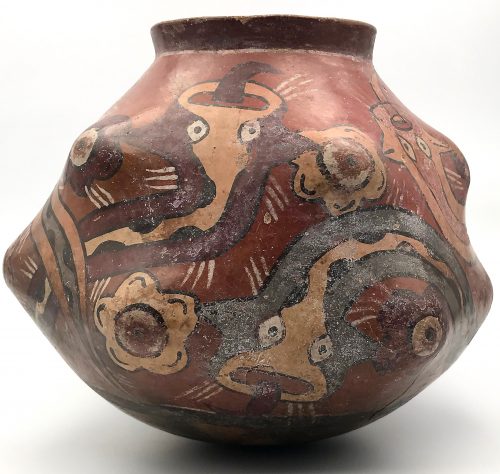
Pre-Columbian, South Coast of Peru, Nazca, ca. 22- BCE - 125 CE.Polychrome vessel of organic, phytomorphic form and thin walls finely painted with six slithering serpents and protruding floral motifs in hues of red, orange, cream, black, grey, and white.
Chips of base and rim. Pressure fissures on and a bit above the base. Surface wear commensurate with age.
Size: Diameter: 19 cm; Height: 16 cm; Mouth diameter: 8.5 cm.
-

Classical picklock bayonet switchblade knife with bolster release, fixed guard, cream handles (ivory?).
Size: 123 mm x 20 mm (closed); 220 mm (opened); 130 mm blade.
Tang is etched with: Havlin. -

Pro-tech Walter Brend custom switchblade knife with solid 416 stainless steel frame, amber jigged bone inlays, mirror polished 154-CM blade.
Size: 94 mm (closed); 168 mm (opned); 74 mm blade)
-

Classical picklock Italian stiletto switchblade knife with bolster release, fixed guard, Brazilian horn handle.
Size: 112 mm (closed); 240 mm (opened); 90 mm blade.
Tang is etched with: Latama, Italy. SOLD -
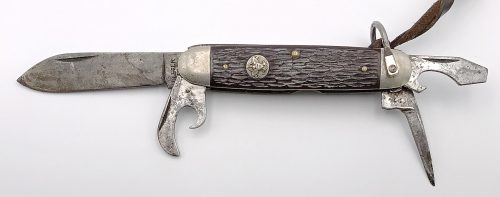
Ulster Official Scout pocket knife with brown jigged bone plastic handles.
Size: 93 mm (closed); 160 mm (opened); 70 mm blade.
Tang is etched with: Ulster -

Iron tsuba of round form decorated with eight roundels – circular emblems of flowers and/or family crests (mon) made of cast brass, pierced and chiseled in kebori, and with flat brass inlay (hira-zōgan) of vines or leaves all over the plate. Both hitsu-ana could have been trimmed with brass now lacking. Nakago-ana of triangular form, possibly enlarged, with copper sekigane. All typical emblems with bellflower, two variations on suhama theme, and 3, 4, 5, and 6-poinitng mon variations. A distinctive character of this tsuba is a mon at 12 hours depicting water plantain (omodaka).
“Omodaka was also called shōgunsō (victorious army grass); because of this martial connotation, it was a design favored for the crests of samurai families” [Family crests of Japan, Stone Bridge Press, Berkeley, California]. Yoshirō school (Kaga-Yoshirō). The Momoyama or early Edo period, beginning of 17th century. Size: Height: 81.4 mm; width: 81.2; thickness 3.8 mm at seppa-dai. -
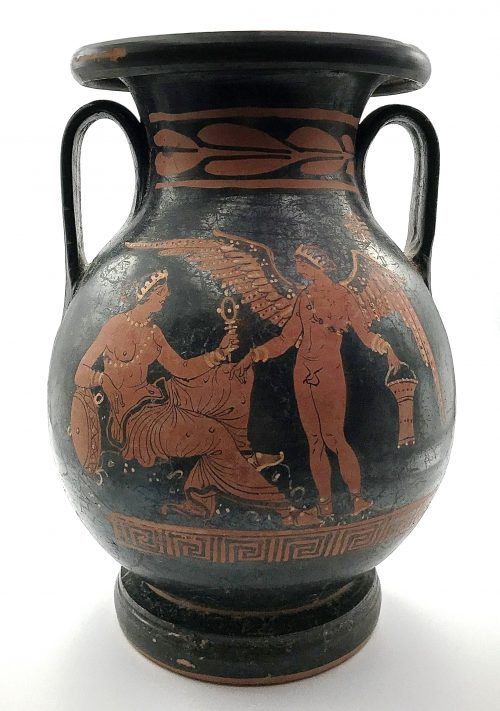 Seller provided description:"Finely painted via the red-figure technique, an elegant pelike vessel of a classic globular form with a cylindrical neck rising to a flared rim, and twin fluted handles, all upon a raised, concave, disc foot.Side A depicts a winged Eros who stands in contrapposto facing toward the left, in the nude save sandals, bracelets, a beaded sash, and a stephane (wreath) holding a situla (pail) in his left hand and gesturing toward the seated maenad before him. Though with her breasts exposed, the maenad does wear a lower garment, and is bedecked with a stephane, multiple bracelets, and strands of pearls around her neck - all delineated in fugitive white and yellow pigment. She holds a mirror in her left upraised hand and leans upon a tambourine with her right elbow. Above and to the right is a maker's mark of a circular format with a central X that is further adorned by nested wedges and dot motifs. Side B presents two opposing standing draped male figures, the gent on the left leaning upon a walking stick. Complementing the figural program, is a lovely decorative program adorning both sides of the vessel, with bands of laurel leaves above and a repeating Greek key/meander below. An outstanding example, masterfully wheel thrown, so that we see absolutely no signs of any jogs in the transitions between the different elements of the vase. Moreover, it presents ideal proportions perfect for presenting the superb painted iconographic/decorative program. The painting was executed with the utmost skill and artistry - the red-figure technique enabling the artist to delineate the figures' musculature, facial details, as well as the cascading drapery folds with extensive fugitive paint embellishments.Expected surface wear with some scuffs and pigment losses commensurate with age, but the painted program is generally very well preserved. Area of repair/restoration to cloak of male on right (Side B). Minute nick to left of male on left (Side B). Nice root marks throughout and areas of encrustation. Thermoluminescence (TL) report: the piece has been found to be ancient and of the period stated. Equivalent age: 2400 +/- 300 years. Certificate of Authenticity from Artemis Gallery. Provenance: private East Coast, USA collection. Greece, Southern Italy, Apulia, ca. 330 BCE.Size: 6.75" in diameter x 9.875" H (17.1 cm x 25.1 cm)Polina de Mauny, being both attentive and knowledgeable, was the first who noticed a possible mistake in the description above. It is highly probable that the woman on side A is not a maenad but Aphrodite herself, holding a mirror and leaning on a shield. Maenads were "often portrayed as inspired by Dionysus into a state of ecstatic frenzy through a combination of dancing and intoxication". The situla, held by Eros, unequivocally alludes to Dionysian ritual, which has to do as much with maenads as with Aphrodite. The nature of two men on side B remain unclear.
Seller provided description:"Finely painted via the red-figure technique, an elegant pelike vessel of a classic globular form with a cylindrical neck rising to a flared rim, and twin fluted handles, all upon a raised, concave, disc foot.Side A depicts a winged Eros who stands in contrapposto facing toward the left, in the nude save sandals, bracelets, a beaded sash, and a stephane (wreath) holding a situla (pail) in his left hand and gesturing toward the seated maenad before him. Though with her breasts exposed, the maenad does wear a lower garment, and is bedecked with a stephane, multiple bracelets, and strands of pearls around her neck - all delineated in fugitive white and yellow pigment. She holds a mirror in her left upraised hand and leans upon a tambourine with her right elbow. Above and to the right is a maker's mark of a circular format with a central X that is further adorned by nested wedges and dot motifs. Side B presents two opposing standing draped male figures, the gent on the left leaning upon a walking stick. Complementing the figural program, is a lovely decorative program adorning both sides of the vessel, with bands of laurel leaves above and a repeating Greek key/meander below. An outstanding example, masterfully wheel thrown, so that we see absolutely no signs of any jogs in the transitions between the different elements of the vase. Moreover, it presents ideal proportions perfect for presenting the superb painted iconographic/decorative program. The painting was executed with the utmost skill and artistry - the red-figure technique enabling the artist to delineate the figures' musculature, facial details, as well as the cascading drapery folds with extensive fugitive paint embellishments.Expected surface wear with some scuffs and pigment losses commensurate with age, but the painted program is generally very well preserved. Area of repair/restoration to cloak of male on right (Side B). Minute nick to left of male on left (Side B). Nice root marks throughout and areas of encrustation. Thermoluminescence (TL) report: the piece has been found to be ancient and of the period stated. Equivalent age: 2400 +/- 300 years. Certificate of Authenticity from Artemis Gallery. Provenance: private East Coast, USA collection. Greece, Southern Italy, Apulia, ca. 330 BCE.Size: 6.75" in diameter x 9.875" H (17.1 cm x 25.1 cm)Polina de Mauny, being both attentive and knowledgeable, was the first who noticed a possible mistake in the description above. It is highly probable that the woman on side A is not a maenad but Aphrodite herself, holding a mirror and leaning on a shield. Maenads were "often portrayed as inspired by Dionysus into a state of ecstatic frenzy through a combination of dancing and intoxication". The situla, held by Eros, unequivocally alludes to Dionysian ritual, which has to do as much with maenads as with Aphrodite. The nature of two men on side B remain unclear. -
 Iron tsuba of round form decorated with eight roundels – circular emblems of flowers and/or family crests (mon) made of cast brass, pierced and chiselled in kebori, and with flat brass inlay (hira-zōgan) of vines or leaves all over the plate. Both hitsu-ana trimmed with brass. Nakago-ana of trapezoidal form. A distinctive character of this tsuba is a mon at 6 hours depicting tomoe (comma). Yoshirō school (Kaga-Yoshirō). Attributed to Koike Yoshirō Naomasa himself. Unsigned. The Momoyama or early Edo period, end of the 16th to the first half of the 17th century (1574-1650). Size: Diameter 82.0 mm, thickness 3.8 mm at seppa-dai, 3.4 mm at rim.
Iron tsuba of round form decorated with eight roundels – circular emblems of flowers and/or family crests (mon) made of cast brass, pierced and chiselled in kebori, and with flat brass inlay (hira-zōgan) of vines or leaves all over the plate. Both hitsu-ana trimmed with brass. Nakago-ana of trapezoidal form. A distinctive character of this tsuba is a mon at 6 hours depicting tomoe (comma). Yoshirō school (Kaga-Yoshirō). Attributed to Koike Yoshirō Naomasa himself. Unsigned. The Momoyama or early Edo period, end of the 16th to the first half of the 17th century (1574-1650). Size: Diameter 82.0 mm, thickness 3.8 mm at seppa-dai, 3.4 mm at rim. -

Iron tsuba of square with cut-off edges form (sumi-iri-kakugata) with lattice design in openwork (sukashi) and solid center. Hitsu-ana plugged with lead.
Unsigned. Late Muromachi period, ca. 16th century.
Size: 81.3 x 80.0 x 3.6 mm References: 1) Tsuba Kanshoki. Kazutaro Torogoye, 1975, p. 95, lower image. It's also called Kyō shōami. 2) KTK-11: Koshi motif, Late Muromachi (16th c.) -

Iron tsuba of square with cut-off edges form (sumi-iri-kakugata) with lattice design in openwork (sukashi) and pierced center.
Unsigned. Late Muromachi period, ca. 16th century.
Size: 73.2 x 72.4 x 3.6 mm References: 1) Tsuba Kanshoki. Kazutaro Torogoye, 1975, p. 95, lower image. It's also called Kyō shōami. 2) KTK-11: Koshi motif, Late Muromachi (16th c.) -

Iron tsuba of mokkō form (mokkōgata) pierced (sukashi) and inlaid with precast dark brass inlay (taka-zōgan) with somewhat abstract/geometrical design that can be liberally described as pines, mist, and snow.
Momoyama or early Edo period. End of the 16th - beginning of the 17th century. Heianjō school. Unsigned. Dimensions: 86.8 x 82.9 x 4.5 mm. -

Thin six-lobed iron plate of brownish color is carved on each side with a groove that follows the rim and a concentric grooves around the center of the plate, also carved with six thin scroll lines (mokkō or handles, kan) that follow the shape of the rim. Mokume surface treatment. Hitsu-ana possibly added at a later date, and kogai-hitsu-ana plugged with gold. Silver sekigane.
Signed: Kunihide [國秀]. Higo school, 1st generation swordsmith.
Mid Edo period, ca. 1800.
Would be possibly attributed to Kamakura-bori school revival of the 19th century.
References: Nihon Tō Kōza, Volume VI / Japanese Sword / Kodōgu Part 1, page 231: Enju Kunihide, a tōshō from Higo: "...forging of the jigane is excellent, and there are also pieces with mokume hada."
Haynes Index Vol. 1, p. 741, H 03569.0: "Enju Kunihide in Higo province, died 1830, student of Suishinshi Masahide. Retainer of the Hosokawa Daimyō, etc."
Additional Information from Markus Sesko: This tsuba indeed is made by Enju Kunihide, who in his later years signed the HIDE [秀] character as HI [日] and DE [出], as here: Size: 77.4 x 74.9 x 2.7 mm
Similar pieces are:
1. In this collection № TSU-0341: Kamakura-bori tsuba with mokkō motif. Muromachi period, 15th - 16th century.
2. Dr. Walter A. Compton Collection, 1992, Christie’s auction, Part II, pp. 14-15, №16: “A kamakurabori type tsuba, Muromachi period, circa 1400. The thin, six-lobed iron plate is carved on each side with a wide groove that follows the shape of the rim, and with six scroll lines and a single thin circular groove. […] The hitsu-ana was added at a later date, circa 1500-1550. Height 8.3 cm, width 8.6 cm, thickness 2.5 mm. The tsuba was initially intended to be mounted on a tachi of the battle type in use from Nambokucho to early Muromachi period (1333-1400)”. Sold at $935.
Size: 77.4 x 74.9 x 2.7 mm
Similar pieces are:
1. In this collection № TSU-0341: Kamakura-bori tsuba with mokkō motif. Muromachi period, 15th - 16th century.
2. Dr. Walter A. Compton Collection, 1992, Christie’s auction, Part II, pp. 14-15, №16: “A kamakurabori type tsuba, Muromachi period, circa 1400. The thin, six-lobed iron plate is carved on each side with a wide groove that follows the shape of the rim, and with six scroll lines and a single thin circular groove. […] The hitsu-ana was added at a later date, circa 1500-1550. Height 8.3 cm, width 8.6 cm, thickness 2.5 mm. The tsuba was initially intended to be mounted on a tachi of the battle type in use from Nambokucho to early Muromachi period (1333-1400)”. Sold at $935.
 3. And another one in Robert E. Haynes Catalog #9 on page 24-25 under №23: “Typical later Kamakura-bori style work. This type of plate and carving show the uniform work produced by several schools in the Muromachi </em period. Some had brass inlay and others were just carved as this one is. The hitsu are later. Ca. 1550. Ht. 8.8 cm, Th. 3.25 mm”. Sold for $175.
3. And another one in Robert E. Haynes Catalog #9 on page 24-25 under №23: “Typical later Kamakura-bori style work. This type of plate and carving show the uniform work produced by several schools in the Muromachi </em period. Some had brass inlay and others were just carved as this one is. The hitsu are later. Ca. 1550. Ht. 8.8 cm, Th. 3.25 mm”. Sold for $175.

-

Thin iron plate of round form and black color carved in sukidashi-bori with design of rocks, waves, clouds, temple gates (torii), mountain pavilion and 5-storey pagoda on both sides, alluding to Todai-ji temple in Nara. Hitsu-ana pierced later. Very narrow very slightly raised rim. Copper sekigane.
Late Muromachi period, 16th century. Dimensions: 88.7 x 88.0 x 2.4 mm (seppa-dai), 1.8 mm (base plate).Reference: “Art of the Samurai” on page 232, №140: ”Kamakura tsuba with Sangatsu-do tower and bridge. Muromachi period, 16th century. 83 mm x 80 mm. Unsigned. Tokyo National Museum. The mountain pavilion and bridge carved in sunken relief on the iron tsuba – both part of Tōdai-ji, a temple in Nara – are detailed in fine kebori (line) engraving. As a result of the chiseling used to create the relief, the ground of the piece is relatively thin".
-

Iron tsuba of mokkō form decorated with inome (wild boar's eye) in openwork (sukashi) outlined with brass wire. The plate decorated with 3 concentric circular rows of brass dots in ten-zōgan. Center of the plate outlined with the inlaid circular brass wire (sen-zōgan). Some dots and the outline of inome on the face are missing.
Ōnin school. Unsigned. Mid Muromachi period, middle of the 15th century. Dimensions: 72.1 x 71.3 x 2.3 mm. -

Iron tsuba of round form with brown patina decorated with the design of a Buddhist temple bell (tsurigane) in openwork (sukashi), with details outlined in brass wire (sen-zōgan), the outer ring decorated with two rows of brass dots (ten-zōgan), and the bell details carved in sukidashi-bori as on kamakura-bori pieces.
Ōnin school. Unsigned. Late Muromachi period, 16th century. Dimensions: 88.8 x 88.3 x 3.0 mm. As per Merrily Baird, two legends are usually associated with the image of tsurigane, a large, suspended Buddhist bell: one is that of Dojo Temple (Dojo-ji), and the other is of Benkei stealing the tsurigane of Miidera Temple. Interestingly, this type of bell (tsurigane) is not described as a family crest (mon), while suzu and hansho bells are. -
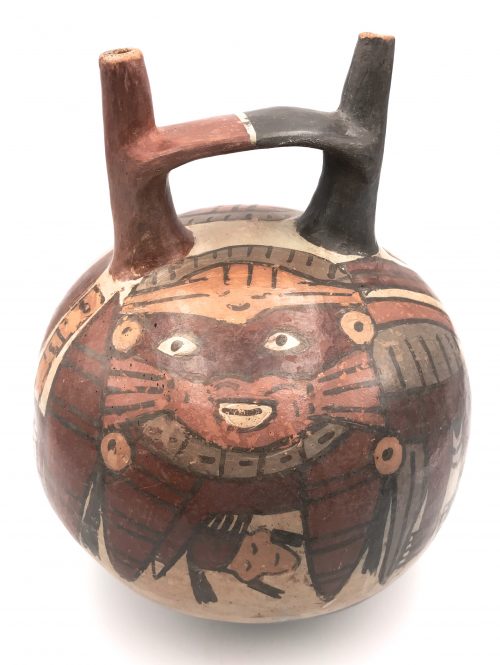
Pre-Columbian, South Coast of Peru, Nazca, ca. 400 - 600 CE. Polychrome double-spout, or stir-up vessel (jar, or bottle), decorated on both sides with designs of masked Mythical Spotted Cat (or the Cat Deity) with a trophy head. Colors: Black, Cream, Gray, Orange, White, Dark Red, Light Red (8 colors).
Size: 17.2 x 14 cm.
References:- A Sourcebook of Nasca Ceramic Iconography: Reading a Culture through Its Art. Donald A. Proulx. University of Iowa Press, 2006; pp. 88-91. [LIB-1556].
- The Archaeology and Pottery of Nazca, Peru: Alfred Kroeber’s 1926 Expedition. Alfred L. Kroeber and Donald Collier, edited by Patrick H. Carmichael with an afterword by Katharina J. Schreiber. AltaMira Press in coop. with Field Museum, Chicago, Il., 1998; p.121. [LIB-1557].
Ex Arte Xibalba, Florida; Ex Robert Dowling Gallery, San Francisco, CA.
-
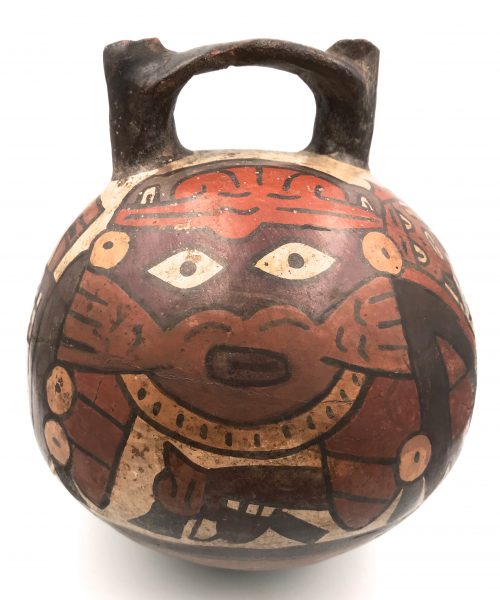
Pre-Columbian, South Coast of Peru, Nazca, ca.200 - 500 CE. Polychrome double-spout, or stir-up vessel (jar, or bottle), decorated on both sides with designs of anthropomorphic Mythical Spotted Cat (or the Cat Deity) with hand holding the club, a trophy head and spears.
Colors: Black, Cream, Gray, Orange, White, Dark Red (7 colors).
Size: Diameter 15.2 cm. References:- A Sourcebook of Nasca Ceramic Iconography: Reading a Culture through Its Art. Donald A. Proulx. University of Iowa Press, 2006; pp. 88-91. [LIB-1556].
- The Archaeology and Pottery of Nazca, Peru: Alfred Kroeber’s 1926 Expedition. Alfred L. Kroeber and Donald Collier, edited by Patrick H. Carmichael with an afterword by Katharina J. Schreiber. AltaMira Press in coop. with Field Museum, Chicago, Il., 1998; p.121. [LIB-1557].
-

Iron tsuba of circular form with design of pine trees (matsu) and monkey toys (kukurizaru) in openwork (ko-sukashi). Ko-Katchushi school.
Raised rim (mimi) with iron bones (tekkotsu). Size: Diameter: 99.5 mm; Thickness: 2.1 mm at centre; 4.3 mm at the rim.Early Muromachi period: 15th century (Kakitsu - Bun'an era, 1441 - 1449).
-

Iron tsuba of round form pierced (sukashi) and inlaid in flat (hira-zōgan) and cast brass (suemon-zōgan), details carved in kebori, with design of two phoenixes, bamboo, and paulownia leaves and flowers (kiri-mon) on both sides. According to seller: Bizen-Yoshirō school (or Heianjō school). Unsigned.
Momoyama period. End of the 16th - beginning of the 17th century. Dimensions: Diameter: 99.5 mm; Thickness: 2.1 mm at centre; 4.3 mm at the rim. According to Merrily Baird (Symbols of Japan), "bamboo teamed with paulownia blossoms or with paulownia and the phoenix, in reference to the Chinese legend that the phoenix perches only on the paulownia and eats only the bamboo". Citation from http://www.clevelandart.org/art/1986.2.1: "The immense heraldic birds on display [...] reflect the Momoyama era's spirit of newly gained self-confidence and an affinity for grand expressive statements in painting, architecture, the textile and ceramic arts, as well as garden design. While that period preceded the arrival of prosperity, it clearly marked an extraordinary moment in Japanese cultural history, one frequently compared with the twelfth century of the Heian period. [...] Rather than an emblem of immortality, as it is in Western lore, in Japan, the phoenix evolved out of its origins in Chinese mythology to become, by the sixteenth century, an auspicious symbol of political authority. Together with clusters of the distinctively shaped paulownia leaves, this long-tailed, mythical bird [...] proclaiming an air of graceful command". -
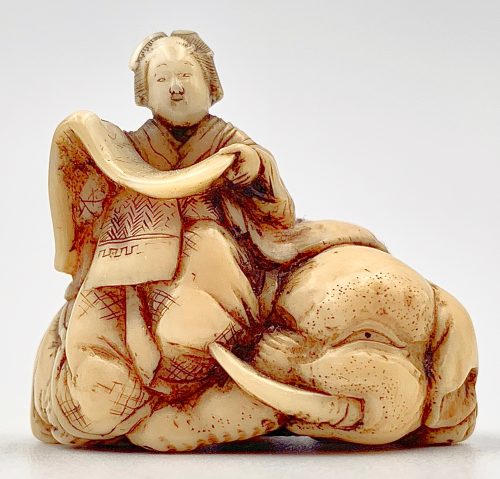 Netsuke of Kimi no Eguchi on a recumbent elephant. Signed: Toun. Circa 1850. 33.7 x 30.8 x 22.7 mm. The Courtesan Eguchi no kimi as Fugen, Bodhisattva of Universal Wisdom (Eguchi no kimi mitate Fugen Bosatsu). The imagery satirizes the Buddhist bodhisattva Fugen, whose iconographic mount is an elephant, by replacing the deity with a beautifully coiffed modern courtesan. Such a visual pun (mitate) was an artistic trope, popular in the Edo period. Provenance: Charles Ephrussi (1849-1905) acquired in the 1870s; a wedding gift in 1898 to his cousin Ritter Viktor von Ephrussi (1860-1945) and Baroness Emilie (Emmy) Schey von Koromla (1879-1938); retrieved post-war by their daughter Elizabeth de Waal (1899-1991); given by her to her brother Ignaz (Iggie) Ephrussi (1906-1994), Tokyo; bequeathed by him to his great-nephew Edmund de Waal (born 1964), London, author of "The Hare with Amber Eyes: a hidden inheritance". London / New York: Chatto & Windus / Farrar, Straus & Giroux. ISBN 978-0099539551. https://en.wikipedia.org/wiki/Charles_Ephrussi. https://en.wikipedia.org/wiki/Ephrussi_family. https://en.wikipedia.org/wiki/Edmund_de_Waal.
Netsuke of Kimi no Eguchi on a recumbent elephant. Signed: Toun. Circa 1850. 33.7 x 30.8 x 22.7 mm. The Courtesan Eguchi no kimi as Fugen, Bodhisattva of Universal Wisdom (Eguchi no kimi mitate Fugen Bosatsu). The imagery satirizes the Buddhist bodhisattva Fugen, whose iconographic mount is an elephant, by replacing the deity with a beautifully coiffed modern courtesan. Such a visual pun (mitate) was an artistic trope, popular in the Edo period. Provenance: Charles Ephrussi (1849-1905) acquired in the 1870s; a wedding gift in 1898 to his cousin Ritter Viktor von Ephrussi (1860-1945) and Baroness Emilie (Emmy) Schey von Koromla (1879-1938); retrieved post-war by their daughter Elizabeth de Waal (1899-1991); given by her to her brother Ignaz (Iggie) Ephrussi (1906-1994), Tokyo; bequeathed by him to his great-nephew Edmund de Waal (born 1964), London, author of "The Hare with Amber Eyes: a hidden inheritance". London / New York: Chatto & Windus / Farrar, Straus & Giroux. ISBN 978-0099539551. https://en.wikipedia.org/wiki/Charles_Ephrussi. https://en.wikipedia.org/wiki/Ephrussi_family. https://en.wikipedia.org/wiki/Edmund_de_Waal. -
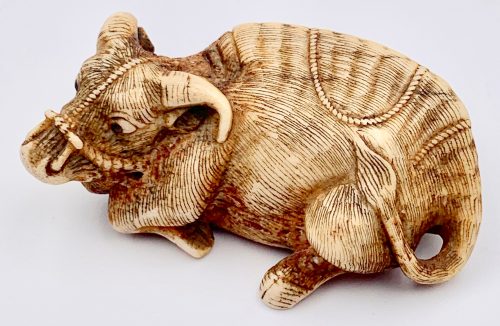 Stag antler netsuke of a recumbent ox. Signed: Tomomasa [友政]. Circa 1800. Dimensions: 56.1 x 20.7 x 36.8 mm Just speculation: There was a master in Kyoto named Tomotada who made netsuke with a recumbent ox motif. Our Tomomasa may be an epigone of a later date. Some even attribute the master to Meiji period. Provenance: Charles Ephrussi (1849-1905) acquired in the 1870s; a wedding gift in 1898 to his cousin Ritter Viktor von Ephrussi (1860-1945) and Baroness Emilie (Emmy) Schey von Koromla (1879-1938); retrieved post-war by their daughter Elizabeth de Waal (1899-1991); given by her to her brother Ignaz (Iggie) Ephrussi (1906-1994), Tokyo; bequeathed by him to his great-nephew Edmund de Waal (born 1964), London, author of “The Hare with Amber Eyes: a hidden inheritance”. London / New York: Chatto & Windus / Farrar, Straus & Giroux. ISBN 978-0099539551. https://en.wikipedia.org/wiki/Charles_Ephrussi. https://en.wikipedia.org/wiki/Ephrussi_family. https://en.wikipedia.org/wiki/Edmund_de_Waal.
Stag antler netsuke of a recumbent ox. Signed: Tomomasa [友政]. Circa 1800. Dimensions: 56.1 x 20.7 x 36.8 mm Just speculation: There was a master in Kyoto named Tomotada who made netsuke with a recumbent ox motif. Our Tomomasa may be an epigone of a later date. Some even attribute the master to Meiji period. Provenance: Charles Ephrussi (1849-1905) acquired in the 1870s; a wedding gift in 1898 to his cousin Ritter Viktor von Ephrussi (1860-1945) and Baroness Emilie (Emmy) Schey von Koromla (1879-1938); retrieved post-war by their daughter Elizabeth de Waal (1899-1991); given by her to her brother Ignaz (Iggie) Ephrussi (1906-1994), Tokyo; bequeathed by him to his great-nephew Edmund de Waal (born 1964), London, author of “The Hare with Amber Eyes: a hidden inheritance”. London / New York: Chatto & Windus / Farrar, Straus & Giroux. ISBN 978-0099539551. https://en.wikipedia.org/wiki/Charles_Ephrussi. https://en.wikipedia.org/wiki/Ephrussi_family. https://en.wikipedia.org/wiki/Edmund_de_Waal. -
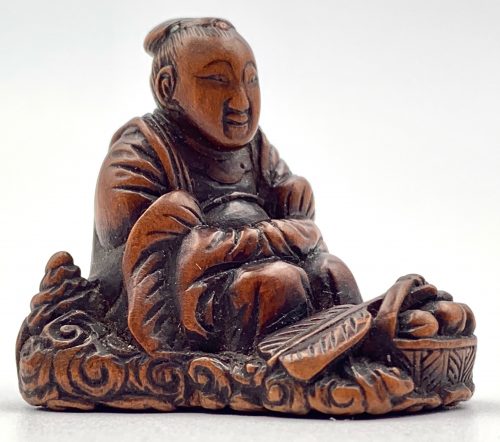 Wood netsuke of Seiōbo with a basket of immortal peaches, seated on a bed of clouds. Carver's signature tablet lost. Circa 1850. Dimensions: 32.6 x 28.1 x 20.1 mm.
Wood netsuke of Seiōbo with a basket of immortal peaches, seated on a bed of clouds. Carver's signature tablet lost. Circa 1850. Dimensions: 32.6 x 28.1 x 20.1 mm.Queen Mother of the West is a calque of Xiwangmu in Chinese sources, Seiōbo in Japan. Peaches of Immortality (Chinese: 仙桃) are consumed by the immortals due to their mystic virtue of conferring longevity on all who eat them.
Provenance: Charles Ephrussi (1849-1905) acquired in the 1870s; a wedding gift in 1898 to his cousin Ritter Viktor von Ephrussi (1860-1945) and Baroness Emilie (Emmy) Schey von Koromla (1879-1938); retrieved post-war by their daughter Elizabeth de Waal (1899-1991); given by her to her brother Ignaz (Iggie) Ephrussi (1906-1994), Tokyo; bequeathed by him to his great-nephew Edmund de Waal (born 1964), London, author of “The Hare with Amber Eyes: a hidden inheritance”. London / New York: Chatto & Windus / Farrar, Straus & Giroux. ISBN 978-0099539551. https://en.wikipedia.org/wiki/Charles_Ephrussi. https://en.wikipedia.org/wiki/Ephrussi_family. https://en.wikipedia.org/wiki/Edmund_de_Waal. -
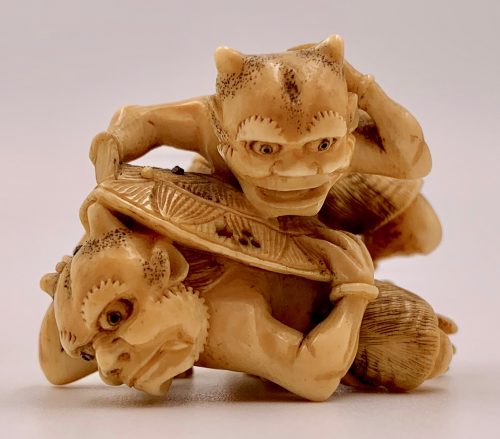
Ivory netsuke with the design of wrestling Oni by Kaigyokusai Masatsugu [懐玉齋正次].
Signed: Masatsugu [正次] Osaka School. Made: 1850-1900; Late Edo - Meiji Period. Dimensions: 44 x 40 x 33 mm.The right hand of the upper Oni and one toe of the lower Oni are missing. Ref.: Raymond Bushell. Collector's netsuke. Weatherhill, NY, Tokyo; Ninth printing, 2002, pp. 84-87. "Kaigyokusai Masatsugu (1813-1892) was an Osaka based carver renowned for his flawless technique as illustrated upon this netsuke with its finely carved ivory form, with no staining and bright inlaid eyes" (V&A).
-
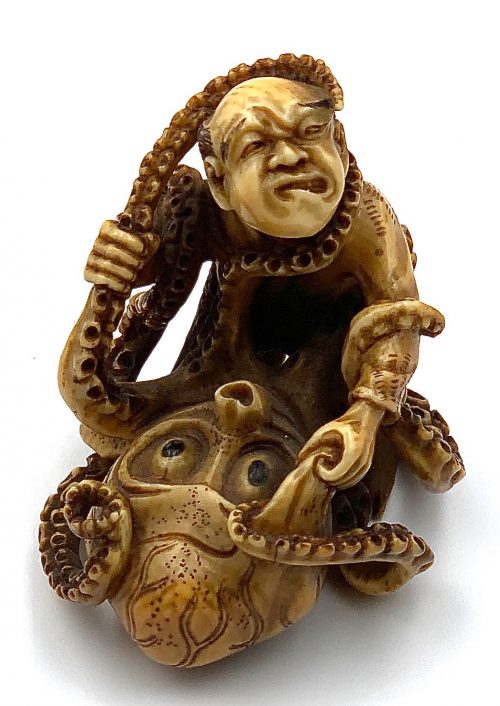
Ivory netsuke with a design of a man (possibly - Ariōmaru) wrestling a giant octopus.
Circa 1850. Dimensions: 45.5 x 48.3 x 37.8 mmUnsigned.
-
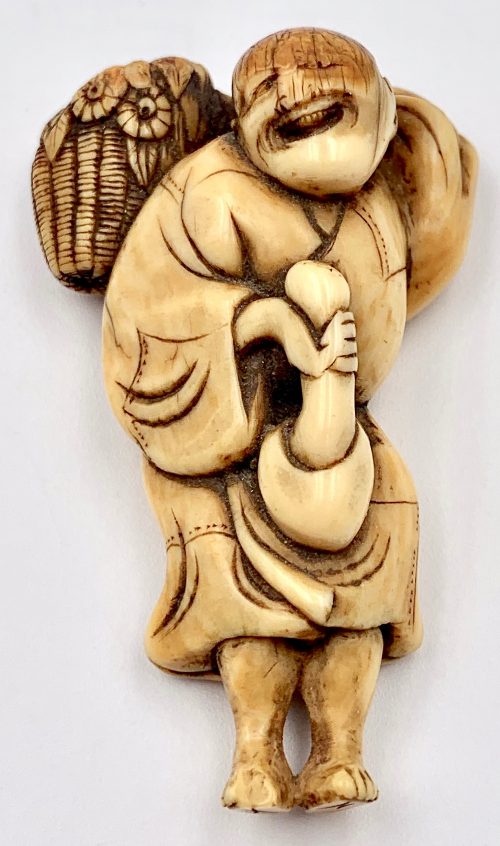
Netsuke with a design of a laughing peasant carrying a basket and holding a giant mushroom in his right hand.
18th century Dimensions: 55.7 mm tallUnsigned. According to Merrily Baird (Symbols of Japan, page. 93): ...Theis prominent use in the symbol-rich netsuke art form, however, reflects more their sexual symbolism than either their dietary appeal or interesting shapes. Mushrooms in Japan are generally a symbol of fertility, with some flat varieties, like shiitake, being associated with females. In contrast, the matsutake mushroom (Armillaria edodes) is a phallic symbol, as befits its thick, spearlike stem and the fact that it is consumed before cap opens.

Female Daruma Riding a Mushroom. Ippitsusai Bunchô. MFA impressions: 11.18513, 21.4758
-

Circular tsuba (marugata ) with design of futatsu-domoe (twofold tomoe) in negative openwork (kage-sukashi), folded-over rim (uchikaeshi-mimi ). The ‘head’ of the left tomoe altered to form an opening for scabbard accessory (kata-hitsu-ana), adorned with gold ategane fitting with file marks (tate-yasurime). The hammer-blow finish of the surface (tsuchime-ji). Signed to the left of nakaga-ana: Yamakichibei (山吉兵). Attributed by Steve Waszak a the Second Generation (Nidai) master.
NBTHK paper [translated by Markus Sesko]:Tomoe-sukashi-tsuba (巴透し鐔).
KANTEI-SHO (鑑定書) - APPRAISAL No 451718
Futatsu-domoe sukashi-tsuba (二巴透鐔) ‒ Tsuba with two tomoe comma openwork design
Signed: Yamakichibei (山吉兵)
Round shape (marugata ), iron, hammerblow finish (tsuchime-ji ), negative openwork design (kage-sukashi ), folded-over rim (uchikaeshi-mimi ), one opening for scabbard accessory
(kata-hitsu-ana) (with gold ategane fitting)
According to the result of the shinsa committee of our society, we judge this work as authentic
and rank it as Hozon Tōsōgu.
February 20, 2007
[Foundation] Nihon Bijutsu Tōken Hozon Kyōkai, NBTHK (日本美術刀劍保存協會)
Diameter: 76 mm, thickness at center 3.9 mm, thickness at rim: 5.1 mm; weight: 102.5 g
Tomoe (Comma): The character 巴 (Chinese pronunciation bā). A pattern resembling the two-comma tomoe (futatsu-domoe) has been found in ancient cultures on all inhabited continents. ...aside from their military function, a ritual or fetish value, perhaps related to their testicular shape. It also has yin-yang connotation. The gold sekigane confirms the high value of the piece to the owner.
-

-
 Iron tsuba of quatrefoil form with design of bamboo stems and leaves in openwork (sukashi) decorated with carving (kebori) . Copper sekigane. Early Edo period, late 17th century (Kanbun / Enppo era). First generation Kanshiro of Nishigaki school in Higo Province died in the sixth year of Genroku, 1693, at the age of 81). Height: 74.4 mm; Width: 74.2 mm; Centre thickness: 4.9 mm. Rounded rim. The design was quite popular among the Higo masters.
Iron tsuba of quatrefoil form with design of bamboo stems and leaves in openwork (sukashi) decorated with carving (kebori) . Copper sekigane. Early Edo period, late 17th century (Kanbun / Enppo era). First generation Kanshiro of Nishigaki school in Higo Province died in the sixth year of Genroku, 1693, at the age of 81). Height: 74.4 mm; Width: 74.2 mm; Centre thickness: 4.9 mm. Rounded rim. The design was quite popular among the Higo masters.
Kanshiro III, early 18th century (Sasano 1994 №267)

Matashichi I, late 17th century (Sasano 1994 №270)
The design of my tsuba closely resembles the one at the last example (Sasano 1994 №280), however, the form (mine is quatrefoil) and the execution (strength) are very different, which result in a very different spirit of my piece.
Shigemitsu II, early 18th century (Sasano 1994 №280)
-

Iron tsuba with chrysanthemum design in openwork (sukashi). Copper sekigane.
Late Heian through Kamakura period (ca. 1150 - 1200's).
Size: 78.4 x 60.9 x 3.5 mm; weight: 45.7 g
Provenance: Boris Markhasin Message from Boris Markhasin (13-AUG-2019): It is a very rudimentary tachi tsuba, and the iron is old and really nothing to draw attention. However, this is a very old tsuba, and that is what makes it very special and an important study piece. This tsuba likely dates to the late Heian through Kamakura (ca. 1150 - 1200's) -- by consensus, since such examples are extremely rare, and none are mounted to my knowledge, so few direct analogues. The form is interesting for a variety of reasons. The smaller size, an oval form is associated more with 12th/13th c styles. The sukashi kiku motif is very interesting as it clearly pushes back the dating of large scale sukashi far back in time. This shouldn't be surprising, but for some reason, we (really mainly westerners) naively tend to associate sukashi with the Muromachi and younger. The two missing spokes are by consensus likely later removals to accommodate kozuka and kogai -- but this is not certain, and it could be an original styling. A key kantei point is the elongate, narrow, slightly squared seppa dai. This is a characteristic of early koshirae, which were much thinner and more delicate than the types we are used to seeing that date pretty much to the late Muromachi and later. I am always amazed when I have a chance to interrogate early koshirae at how thin they are - I want to call them fragile, but they were actually quite resilient. The walls were super thin, but the top and bottom edges were a bit thicker, providing a bit of structural support... but this is another thread topic. Of all the tsuba I have owned, this is the tsuba that has most clearly reflected the shape of the old style of saya / tsuka. -

Large iron tsuba with hammer marks on the surface, small oval opening to the right of nakaga-ana; yamagane fukurin chiselled with tortois shell diaper pattern.
Early Muromachi period (1393-1453). Size: 101.2 x 101.9 x 2.4 (center), 5.2 (rim) mm; weight: 148.4 g. -

Iron tsuba with hammer marked surface and design of a plum and cherry blossoms to the right of nakaga-ana in openwork (sukashi). Raised rim, typical to katchushi school. The thickness of the plate provides for later Muromachi period making.
Late Muromachi period (1514-1573). Size: 85.8 x 85.0 x 3.6 (center), 4.1 (rim) mm; weight: 136 g. -
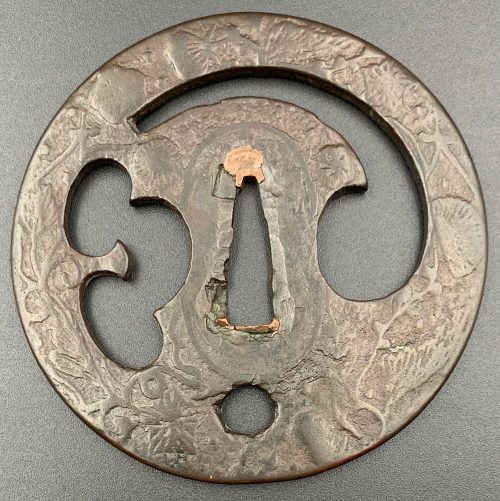
Yamagane (bronze) tsuba (kagami-shi, or mirror-maker) with the design of a star (round opening), tomoe (comma), and suhama in openwork. Surface cast and chiselled with the design of foliage, vines, blossoms, pine needles, and fruits on both sides.
The end of Early Muromachi period (1393-1453), circa 1450. Size: 83.7 x 84.1 x 3.6 (center), 4.1 (rim) mm; weight: 135.5 g. KANTEI-SHO (鑑定書) - APPRAISAL [translated by Markus Sesko]. No 463341 Tomoe-suhama-sukashi hana-karakusa no zu tsuba (巴洲浜透花唐草図鐔) ‒ Tsuba with stylized comma and bay inlet openwork and a flower and arabesque décor Unsigned: Kagami-shi (鏡師) Round shape, yamagane, hammer blow finish, cast, negative openwork design, round rim. According to the result of the shinsa committee of our society, we judge this work as authentic and rank it as Hozon Tōsōgu. July 1, 2011 [Foundation] Nihon Bijutsu Tōken Hozon Kyōkai, NBTHK (日本美術刀劍保存協會) -

Yamagane (bronze) tsuba (kagamishi, or mirror-maker) with the design of tomoe (comma) and suhama in openwork. Surface treated with hammer marks and chiselled with the design of maple leaves and encircled two bars (maru-ni-futatsu-biki, Ashikaga clan family crest, or mon) on both sides. Raised rim or rim cover (fukurin). Custom kiri-wood box.
Size: 87.4 x 86.2 x 2.9 (center), 4.9 (rim) mm; weight: 120 g. -

Small iron tsuba (tantō size) of aoi form with the design of paulownia leaves and blossoms in copper and brass flat inlay (hira-zōgan). Brass sekigane. Open kozuka hitsu-ana.
Early Edo period, 17th century.
Size: 53.4 x 40.7 x 4.4 mm; weight: 47.4 g
-

Small iron tsuba (tantō size) of oval form carved with imitation of six overlapping plates, decorated with paulownia blossoms, leaves, and tendrils in brass and copper hira-zōgan. Copper sekigane. Open kozuka hitsu-ana.
Early Edo period, 17th century.
Size: 50.5 x 34.0 x 4.9 mm.
-

Iron tsuba of diamond form with rounded corners with the design of a double gourd on a branch in openwork. Dark brown patina. Ko-Shōami school. Custom kiri-wood box with hakogaki of Sasano Masayuki.
Momoyama Period (1574-1603)
Size: 77.1 x 75.7 x 4.6 mm; weight: 75.3 g.
Provenance: Sasano Masayuki[Translated by Markus Sesko]Hakogaki lid outside: 古正阿弥鐔 Ko-Shōami tsuba Hakogaki lid inside:Hyōtan-sukashi Mumei, Momoyama-ki saku Tetsu, ji-sukashi Koboku-aware no kasaku Heisei ninen Soshinkan Minazuki Openwork design of gourd Unsigned, Momoyama era work Iron, large openwork Masterwork full of classical charm. June of 1990, Soshinkan [pen name of Sasano Masayuki]瓢簞透 無銘 桃山期作 鉄地透
古撲惻之佳作 平成二年 素心鑑 水無月
-
 Iron tsuba of six-lobed (mutsu-mokkō-gata) form, with six wild boar's eye shape (inome) openings (sukashi). Ryo-Hitsu and the entire perimeter of tsuba have typical for this school raised rim; raised seppa dai. Lobes are decorated in low relief carving (sukidashi-bori). On the obverse: chrysanthemum, Genji mon, waves and rocks, grasses and star, bellflower, star and flower in tortoiseshell (kikko). On the reverse: Stars and different flowers, and flying geese. The plate is damaged to the left of nakago-ana and around the left hitsu-ana. Kamakura-bori school. Late Muromachi period (1514-1573). Diameter: 89 mm; Thickness at seppa-dai: 4.0 mm; Weight: 108.8 g [large]. There is a similar tsuba in this collection, TSU-0345.2018, but with a different motif and much smaller: diameter 74.3 mm, thickness at seppa-dai: 3.2 mm, weight: 62.8 g.Another look-a-like tsuba can be found at the Compton Collection, part II, pp. 14-15, №17, though his tsuba is more massive (80 x 84 x 4 mm).
Iron tsuba of six-lobed (mutsu-mokkō-gata) form, with six wild boar's eye shape (inome) openings (sukashi). Ryo-Hitsu and the entire perimeter of tsuba have typical for this school raised rim; raised seppa dai. Lobes are decorated in low relief carving (sukidashi-bori). On the obverse: chrysanthemum, Genji mon, waves and rocks, grasses and star, bellflower, star and flower in tortoiseshell (kikko). On the reverse: Stars and different flowers, and flying geese. The plate is damaged to the left of nakago-ana and around the left hitsu-ana. Kamakura-bori school. Late Muromachi period (1514-1573). Diameter: 89 mm; Thickness at seppa-dai: 4.0 mm; Weight: 108.8 g [large]. There is a similar tsuba in this collection, TSU-0345.2018, but with a different motif and much smaller: diameter 74.3 mm, thickness at seppa-dai: 3.2 mm, weight: 62.8 g.Another look-a-like tsuba can be found at the Compton Collection, part II, pp. 14-15, №17, though his tsuba is more massive (80 x 84 x 4 mm).
Varshavsky Collection: TSU-0345.2018
This tsuba, TSU-0401.2019, is the biggest of all three (another mine and the one from Campton Collection). The presence of a flower in a tortoiseshell symbol (crest or mon) on this tsuba alludes to Izumo Shrine. The overall piece, with symbols of grasses, waves, flowers, incense, stars, and flying geese, is full of autumnal connotations.
Compton Collection, part II, pp. 14-15, №17: Kamakura-bori tsuba, ca. 1450.
-
 Iron tsuba of round form adorned with the design of stars, wild geese, floating blossoms, leaves and tendrils realized in brass inlay. The inlay technique includes suemon-zōgan and ten-zōgan. Two smaller openings (hitsu-ana) surrounded by a scalloped brass border. The seppa-dai border inlay is missing, as well as a few other fragments of inlay on both sides. Sword cut at 12 o'clock on the reverse. A tsuba with a strong autumnal connotation, which once belonged to a great battle weapon. One of only three known jūyō Ōnin tsuba. Translation of the paper, issued by the Japanese sword fittings (tosogu) examination board: Designated as jūyō-tosogu at the 34th jūyō-shinsa held on April 14th 1988 Kaki-karimon zōgan-tsuba (花卉雁文象嵌鐔) — Tsuba with zōgan design of flowers and wild geese. Mumei: Onin (応仁) Tokyo. Nakasono Tokumi (中園とくみ) Measurements: height 9.5 cm, width 9.4 cm, thickness at rim 0.35 cm Interpretation: marugata, iron, brass zōgan, two hitsu-ana Time: end of Muromachi Explanation: Ōnin-tsuba are thin iron ita-tsuba which show a brass zōgan ornamentation. All of them are mumei and there is the theory that they were made in the Onin era (1467-1469) although today more and more the theory is accepted that they are in general late Muromachi period works. There are two kinds of brass zōgan interpretations: One depicts irregularly arranged tachibana branches, wild geese, chrysanthemums, flowers, or karakusa for example, and the other one shows punctual zōgan elements, which are referred to as hoshi-zōgan or ro-zōgan, and concentrical zōgan elements between the nakago-ana and the rim. The latter interpretations might also be accompanied by simple ko-sukashi in the form of butterflies, clouds, hats, or stylized mountains. This tsuba is a typical work from the former category. It is large and feels massive and the powerful and impressive zōgan and the excellent iron make it a highly tasteful piece. Back side: Issued to: Nakasono Tokumi Address: Tokyo-to, Suginami-ku, Kamitakaido 2-17-26 Date of issue: May 30th 1989
Iron tsuba of round form adorned with the design of stars, wild geese, floating blossoms, leaves and tendrils realized in brass inlay. The inlay technique includes suemon-zōgan and ten-zōgan. Two smaller openings (hitsu-ana) surrounded by a scalloped brass border. The seppa-dai border inlay is missing, as well as a few other fragments of inlay on both sides. Sword cut at 12 o'clock on the reverse. A tsuba with a strong autumnal connotation, which once belonged to a great battle weapon. One of only three known jūyō Ōnin tsuba. Translation of the paper, issued by the Japanese sword fittings (tosogu) examination board: Designated as jūyō-tosogu at the 34th jūyō-shinsa held on April 14th 1988 Kaki-karimon zōgan-tsuba (花卉雁文象嵌鐔) — Tsuba with zōgan design of flowers and wild geese. Mumei: Onin (応仁) Tokyo. Nakasono Tokumi (中園とくみ) Measurements: height 9.5 cm, width 9.4 cm, thickness at rim 0.35 cm Interpretation: marugata, iron, brass zōgan, two hitsu-ana Time: end of Muromachi Explanation: Ōnin-tsuba are thin iron ita-tsuba which show a brass zōgan ornamentation. All of them are mumei and there is the theory that they were made in the Onin era (1467-1469) although today more and more the theory is accepted that they are in general late Muromachi period works. There are two kinds of brass zōgan interpretations: One depicts irregularly arranged tachibana branches, wild geese, chrysanthemums, flowers, or karakusa for example, and the other one shows punctual zōgan elements, which are referred to as hoshi-zōgan or ro-zōgan, and concentrical zōgan elements between the nakago-ana and the rim. The latter interpretations might also be accompanied by simple ko-sukashi in the form of butterflies, clouds, hats, or stylized mountains. This tsuba is a typical work from the former category. It is large and feels massive and the powerful and impressive zōgan and the excellent iron make it a highly tasteful piece. Back side: Issued to: Nakasono Tokumi Address: Tokyo-to, Suginami-ku, Kamitakaido 2-17-26 Date of issue: May 30th 1989 -

Oblong round shape (nagamaru-gata) tsuba with design of dragonfly (tombo or katsumushi) and wheel (kuruma) in negative openwork (kage-sukashi), round rim (maru-mimi ). Copper sekigane.
Okamoto Yasukazu's Owari to Mikawa no tankō, №181 characterizes the tsuba as follows: "Katsumushi, kuruma-sukashi no zu (dragonfly and wheel sukashi). Mei: Yamakichibei (Shodai). Such small tsuba are rare for the Shodai. The nakago-ana is also small so it was probably intended to be mounted on a tantō. Regardless of its size, the iron is outstanding and the workmanship shows the characteristic features of the Shodai (first generation). The kuruma-sukashi design is interpreted here in a half-moon shape and only on one side of the tsuba. Such a design is also seen on works of the Nidai (second generation)...". Signed to the left of nakaga-ana: Yamakichibei (山吉兵へ). Attributed to the First Generation (Shodai) master.
NBTHK paper (translated by Markus Sesko): The Tokubetsu-Kichō Kodōgu. Kachimushi-kuruma sukashi-tsuba (勝虫車透鐔) - Tsuba with sukashi motif of dragonfly and cartwheel. Signed: Yamakichibei (山吉兵). Iron, marugata, ko-sukashi. Issued on April 1, 1977. [Copy only] Dimensions: H: 66 mm; W: 63.2 mm; Th(center): 3.8 mm; Th(rim): 3.5 mm. Weight: 68 g. -
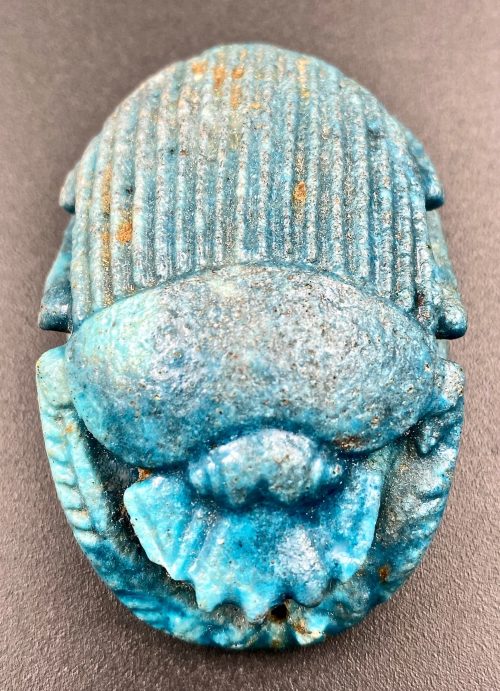 Egypt, Late Period. The oval amulet with multiple pierced holes for stitching to the outer garments of a mummy or the mummy wrappings, reeded wings and braided claws, marine blue in colour. According to the Brooklyn Museum, such faience amulets formed part of the beadwork pattern and served to protect the mummy through their magical properties. It served as a substitute heart that would ensure continued existence in the hereafter. A similar example at the Brooklyn Museum dated ca. 712-342 BC. Dimensions: 55 x 37 mm Provenance: The Collection of Erwin Harvith (1918 – 2011) and Sylvia Redblatt Harvith (1920 – 2015), Detroit, MI, acquired in 1972 directly from the Collection of Moshe Dayan, (משה דיין; 1915 – 1981), an Israeli military leader and politician. Exhibited: Jewish Museum, New York, NY, "Culture and Continuity – The Jewish Journey", 1975.
Egypt, Late Period. The oval amulet with multiple pierced holes for stitching to the outer garments of a mummy or the mummy wrappings, reeded wings and braided claws, marine blue in colour. According to the Brooklyn Museum, such faience amulets formed part of the beadwork pattern and served to protect the mummy through their magical properties. It served as a substitute heart that would ensure continued existence in the hereafter. A similar example at the Brooklyn Museum dated ca. 712-342 BC. Dimensions: 55 x 37 mm Provenance: The Collection of Erwin Harvith (1918 – 2011) and Sylvia Redblatt Harvith (1920 – 2015), Detroit, MI, acquired in 1972 directly from the Collection of Moshe Dayan, (משה דיין; 1915 – 1981), an Israeli military leader and politician. Exhibited: Jewish Museum, New York, NY, "Culture and Continuity – The Jewish Journey", 1975. -
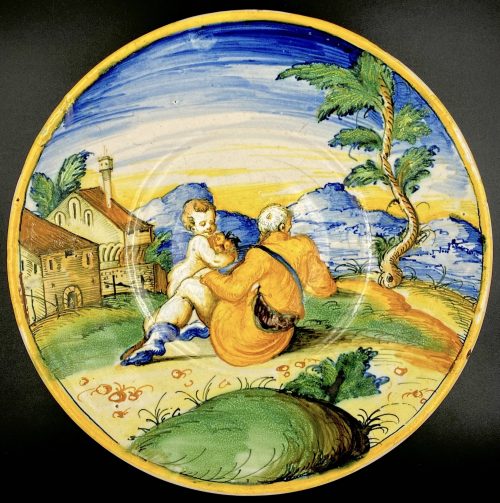
-
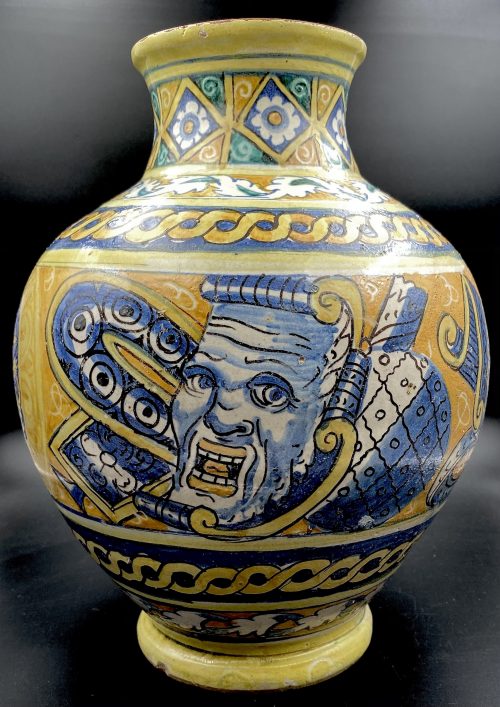
-

A very thin kobushi-gata form iron tsuba decorated in openwork (sukashi), some openings filled with grey metal (silver or pewter) treated in a way to resemble cracked ice, ginkgo leaf to recto and plum blossoms to verso in low-relief (takabori) and gold inlay (zōgan), and unevenly folded over rim (hineri-mimi). The overall theme of the piece is linked to the icy ponds, falling ginkgo leaves and blossoming plums in the late winter.
Size: 84 x 80 mm, thickness (center): 2 mm.Signed: Yamashiro no kuni Fushimi no ju Kaneie [Kaneie of Fushimi in Yamashiro Province] [山城國伏見住金家], with Kaō.
Probably the work of Meijin-Shodai Kaneie (c. 1580 – 1600).
The silver or pewter inlays likely a later work that may be attributed to Goto Ichijo (1791 – 1876) or one of his apprentices in the late 19th century, possibly as a tribute to the great Kaneie masters. Here is an article by Steve Waszak dedicated to Kaneie masters and this tsuba in particular.Kaneie
For many tosogu aficionados, this name reigns supreme among all tsubako across Japanese history. The first Kaneie is celebrated for many things. He is recognized as being the first ever to bring pictorial landscape subjects to a canvas so small as that of a tsuba plate. His skill in being able to render classical Chinese landscape themes while working with a material as unyielding as steel, and to do so with the sensitivity he does, is nothing short of astounding. The quality of his workmanship — especially that of his exquisitely carved motif elements and the extraordinary deftness of his tsuchime (槌目 or 鎚目, hammer-blow) utilizing such thin plates — astonishes even to this day. His sensibilities concerning the shaping of his sword guards and the presentation of the rims were no less innovative than his subject matter. He was among the very first to regularly sign his name as a tsuba smith. And it is likely that he served the great warlord Toyotomi Hideyoshi in the latter years of the 16th century. Despite the great fame and reputation of Kaneie, very little of the lives of the two men who are seen by most scholars as the “true Kaneie” tsubako of the Momoyama and earliest Edo Periods is known to us now. They were both smiths working in steel, with occasional added soft-metal inlay (usually serving to highlight features), and both made sword guards of the same style, using subject matter focused on landscapes, allusions to historical events, or religious themes. The first of these men is often referred to as “O-Shodai,” or Great First Generation, while the second is known as “Meijin-Shodai,” or Famous First Generation. While some see subsequent generations stemming from these first two men, others have the O-Shodai and the Meijin-Shodai as THE two true Kaneie and make a sharp distinction between these two smiths and any others who may share the name.The work of the O-Shodai may appear with two different mei. One of these is written “Joshu Fushimi Ju Kaneie,” while his work may also carry a mei reading “Yamashiro no Kuni Fushimi Ju Kaneie.” It is thought by some scholars that the earlier works present with the “Joshu” mei, while his later works feature the “Yamashiro” mei. However, there are only some five or six tsuba extant with the “Joshu” signature, so we should not necessarily see works with the “Yamashiro” signature as dating only to the latest years of his working life. The answers to the questions of exactly when Kaneie might have begun his life as a tsubako, or how old he was when he moved to sign his works with the “Yamashiro” mei, will probably remain shrouded in uncertainty.The association between Kaneie and Toyotomi Hideyoshi is speculative, to be sure, but the circumstantial evidence is tantalizing. The area of Fushimi is thought to have been an entirely unremarkable land prior to Hideyoshi’s building of a castle there, so it would seem unlikely that the first Kaneie would have been working in such a nondescript place, much less including the place name in his mei, before Hideyoshi’s putting it on the map, so to speak. Why emphasize such pride of place in one’s signature unless the place itself carries a certain weight? The name “Kaneie” translates roughly to “gold family,” which, given Hideyoshi’s notorious love of gold, would seem too much of a coincidence when combined with the explicit mention of Fushimi in the signatures. Combine this with the consideration of what is an equally compelling relationship between the celebrated tsubako Nobuie and Oda Nobunaga (“Nobuie” means roughly “of the family of “Nobu”), whom Hideyoshi served as a top general until Oda’s demise in 1582, and the circumstantial evidence becomes even harder to deny the plausibility of. Oda, ever the innovator, may have been the one responsible for birthing the practice of tsubako regularly signing their works. Having a superb smith like Nobuie affix the name to the tsuba as a regular practice establishes a sort of “brand name,” a brand coming with the seal of approval of Oda Nobunaga. It is more than possible that Nobunaga may have then used these valuable sword guards as rewards given to vassals and other important relations to honour them for their services to him, a practice that would have allowed Nobunaga to avoid having to use gold, guns, swords, horses, or land to do so. The awarding of a magnificent Nobuie tsuba to a deserving warrior, an appreciated ally, or a family member would bring honour to the recipient, of course, but would also honour the maker of the sword guard, and even the giver of the object. Such a way of thinking would be absolutely typical of him, and given that both Oda Nobunaga and Nobuie were men of Kiyosu in Owari in the early Momoyama Period, it does not strain credulity to imagine that the above dynamic could have occurred in just this way. If indeed it did, Toyotomi Hideyoshi is unlikely to have let this pass unnoticed. He may even have been so honoured himself! When he rose to power very shortly after Oda’s death, then, and when he reinforced and consolidated that power in the late 1580s and early 1590s, which included the building of the castle at Fushimi, perhaps he sought to emulate the Oda vision and practice of establishing a “royal tsubako.” If so, Kaneie would have been that smith.As noted, this scenario is speculative, and not a little romantic. This does not mean, however, that it is in fact not likely, for there would be a number of coincidences involved for it to be entirely false.Tsuba scholars will say that Kaneie’s skills in the making of his sword guards indicate an armour-making background. This is an interesting viewpoint, but one can’t help but wonder how many armourers were possessed of such fluent literacy in lyrical Chinese historical tales that they could then represent them as motifs on steel plates. Kaneie subjects often are in the form of Chinese landscapes and allusions, as noted, one of which — The Eight Views of the Xiao and the Xiang — was very well known as a famous subject of Chinese painting and poetry from the Song Dynasty. There exist Kaneie tsuba which depicts at least some of these “views,” and it seems unlikely that if one or more of them were to be created, not all of them would be, in a sort of “series.” The cultural and literary fluency Kaneie would seem to have had, then, may suggest a Buddhist background, and indeed, some of the subjects seen are explicitly Buddhist in nature. Perhaps his background then, somehow offering a dovetailing of metalwork and Buddhist teachings; in any event, we are all the richer for at least some of the works of Kaneie to have survived to reach us today.One of the hallmarks of Kaneie tsuba (real ones) is the extreme thinness of the plate, combined with utterly superb tsuchime expression of that plate. To be able to hammer the plate to achieve such strength of expression while the plate is so thin is seen by the Japanese as practically miraculous. A notable and important kantei point between the early masterpieces by the two “Shodai” Kaneie and the tsuba made by followers is this thinness of the plate. Another kantei point: because the plate is so thin when raised areas representing motif elements are present, they are inlaid into the plate, because trying to carve them from such a thin plate would be practically impossible: the likelihood of piercing the plate would be high, and the plate in that area, even if not pierced, would be significantly weakened by trying to manage the raising of a motif element from the plate. In real Kaneie works, then, one would expect any raised motif elements to be inlaid.Other highlights: the “Shodai” Kaneie are famous for the kobushi-gata (拳形) or “fist-shaped” design in their work, but despite this, there actually aren’t that many extant sword guards boasting this shape. Another feature for which the Kaneie are justly famous is their folding over of the lip of the rim onto the plate in a very tasteful manner, just here and there, rather than uniformly across the tsuba. However, again, this feature is actually not commonly seen, either. The combination, then, of a kobushi-gata shape with the rim folded over in just a few areas is that much rarer.Which brings us to the featured piece.Here is a Kaneie tsuba, a “Meijin-Shodai” Kaneie, which presents with a very thin plate, being between 1.5 and 2mm in thickness. The motif elements are inlaid, as we should expect. The sugata (姿, shape) is Kobushi-gata with the rim folded over in only a few places, representing a relatively infrequently encountered form, as stated. The tsuba here is fortunate not to have any added hitsu-ana, unlike many or most other Kaneie do. The sukashi elements are fascinating to consider, being difficult to determine the meaning of; however, the raised elements clearly point to a seasonal motif, with cherry and plum blossoms on the omote for Spring, and ginkgo on the ura for Fall. The inlaid metal in two of the openings — silver, shibuichi, or pewter, perhaps — is very likely a later addition, probably 19th-century, and more specifically, late-19th-century. The finishing on these inlaid portions has all the hallmarks of Goto Ichijo workmanship. Namely, the treatment of the surface of the inlay to resemble fallen snow (in the Japanese sense of things) is expressed in a very Ichijo sense of things, and, given the great importance of Kaneie tsuba, and the seasonal expression the motif of the guard has, it is plausible that the inlay is Ichijo work or that of one of his top students. In any event, this inlay complements the rest of the tsuba beautifully. The inlay also resembles the art of kintsugi (金継ぎ, golden joinery) or the Japanese practice of ceramic repair using lacquer when a piece is particularly special or important. In this way, a nod is given to Tea Culture, too, creating a wonderful blending of associations and allusions, typical of the highest Japanese aesthetic sense.At 8.4cm, the tsuba is of an excellent size and is in great condition (no rust, no deep rust pitting, no fire damage). There is, intriguingly, one small sign of battle damage at 6:00 on the guard: it would seem a sword blow cut into the tsuba at the rim, and penetrated slightly into the plate. The superb repair represented by a little stitch or two right at the rim and along a few millimetres of the plate is visible on very close inspection. The repair is old, probably nearly contemporary with when the tsuba was made. Given the high status of Kaneie in their lifetime (as tsubako for Hideyoshi, one might imagine their importance), and given the obvious high quality of this piece, it is not surprising that the finest repair efforts were put into its care.The name Kaneie justly enjoys its fame and accolades as pre-eminent among the tens of thousands of tsubako in Japanese history. We are fortunate indeed to have had a small number of the works of the early masters survive to this day. The first of their kind, and as most scholars and aficionados would wholeheartedly agree, the best of their kind, Kaneie sword guards remain among the very finest examples of the Japanese metal-working traditions. -
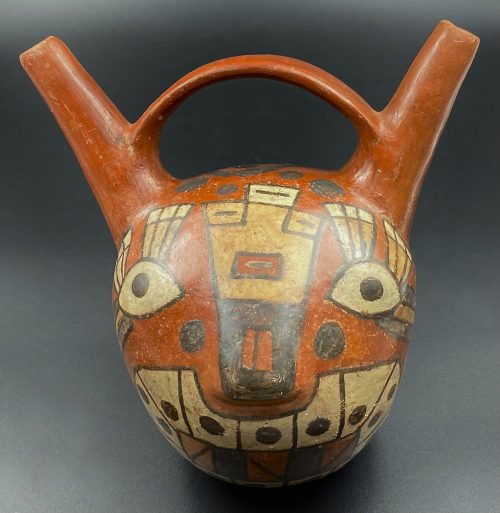 Pre-Columbian, Peru, Wari (Huari) culture, ca. 650 to 1000 CE.
Pre-Columbian, Peru, Wari (Huari) culture, ca. 650 to 1000 CE.A hand-built polychrome ceramic stirrup vessel depicting the head of a jaguar. Painted with a sienna-hued base, this spotted beast features an abstract visage of almond-shaped eyes opened wide with long feather-like lashes, a rectangular nose protruding from a nasal bridge decorated with a quadrilateral motif, and a large open mouth, showing both upper and lower teeth, which are also spotted, all painted in shades of cream, black, cream, grey, light grey, and beige. Highly burnished, the lustrous vessel exhibits two spouts, also functioning as ears of the jaguar, with a flat handle arching between them. This tool would have been a grave good intended to hold some kind of libation or offering and was likely made in a specialist workshop.
Colours: Sienna (base), black, cream, grey, light grey, beige (7 colours).
Dimension: Width (mouth-to-mouth): 15 cm; Height: 14.5 cm; Diameter of the body: 10.5 cm. Provenance: Hans Juergen Westermann collection, Germany. The Wari State was the first expansionistic power to develop in the Andean highlands. It was located in Vilcabamba, modern Espiritu Pampa (Plain of the Spirits), Echarate District of La Convención Province in the Cuzco Region of Peru. The Wari expanded around AD 650 and by the time of their collapse in AD 1000 they controlled much of the central Andes. -
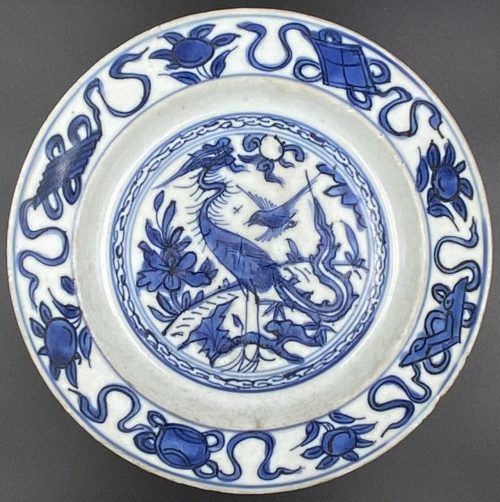 Plate with crane, bird, plants, and four treasures. Porcelain with underglaze blue decoration and illegible factory mark to the bottom. Ming Dynasty [大明] (1368 – 1644); Wanli Era (1572 – 1620); Late 16th – Early 17th century. Diameter: 19.5 cm; Height: 3 cm
Plate with crane, bird, plants, and four treasures. Porcelain with underglaze blue decoration and illegible factory mark to the bottom. Ming Dynasty [大明] (1368 – 1644); Wanli Era (1572 – 1620); Late 16th – Early 17th century. Diameter: 19.5 cm; Height: 3 cm -
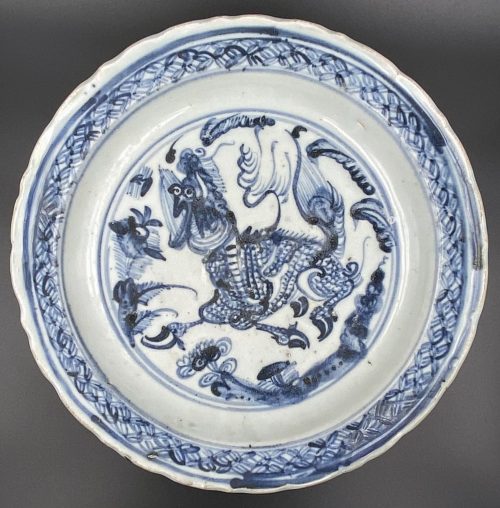 Footed plate with scalloped rim, centre decorated with running yak or another even-toed animal among flowers, jewel diaper pattern to the inner lip; foliage motif to the outside is bordered with foliage above and lotus leaves below. Porcelain with underglaze blue decoration. Ming Dynasty [大明] (1368 – 1644); Wanli Era (1572 – 1620); Late 16th – Early 17th century. Diameter: 25.5 cm; Height: 4.2 cm
Footed plate with scalloped rim, centre decorated with running yak or another even-toed animal among flowers, jewel diaper pattern to the inner lip; foliage motif to the outside is bordered with foliage above and lotus leaves below. Porcelain with underglaze blue decoration. Ming Dynasty [大明] (1368 – 1644); Wanli Era (1572 – 1620); Late 16th – Early 17th century. Diameter: 25.5 cm; Height: 4.2 cm -
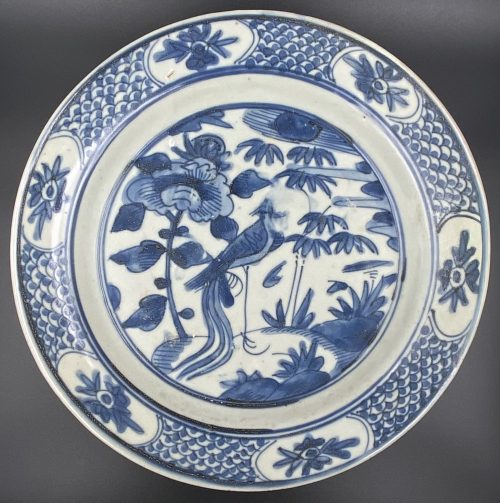 Underglaze cobalt blue and white Zhangzhou (Swatow) porcelain plate decorated vigorously and spontaneously with a bird in the landscape, and flowers in oval cartouches among waves or fish scale diaper. Sand particles on the base. Ming Dynasty [大明] (1368 – 1644); Wanli Era (1572 – 1620); Late 16th – Early 17th century. Diameter: 28.2 cm; Height: 4.0 cm
Underglaze cobalt blue and white Zhangzhou (Swatow) porcelain plate decorated vigorously and spontaneously with a bird in the landscape, and flowers in oval cartouches among waves or fish scale diaper. Sand particles on the base. Ming Dynasty [大明] (1368 – 1644); Wanli Era (1572 – 1620); Late 16th – Early 17th century. Diameter: 28.2 cm; Height: 4.0 cm -
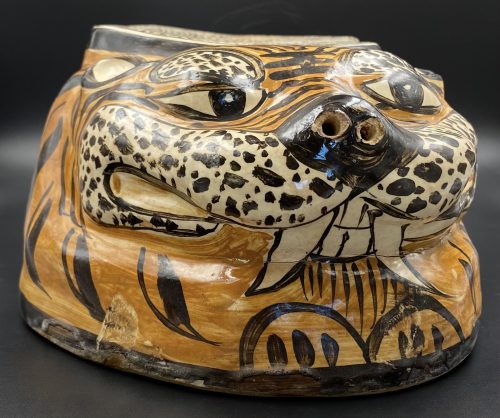 The pillow is moulded as a recumbent tiger, the details painted in dark brown and pale russet on a white slip and under a clear glaze, and the slightly dished top is painted with a winged beast. China, the Jin dynasty [金朝] (1115 – 1234). Dimensions: 12 x 34.5 x 19.5 cm
The pillow is moulded as a recumbent tiger, the details painted in dark brown and pale russet on a white slip and under a clear glaze, and the slightly dished top is painted with a winged beast. China, the Jin dynasty [金朝] (1115 – 1234). Dimensions: 12 x 34.5 x 19.5 cm -
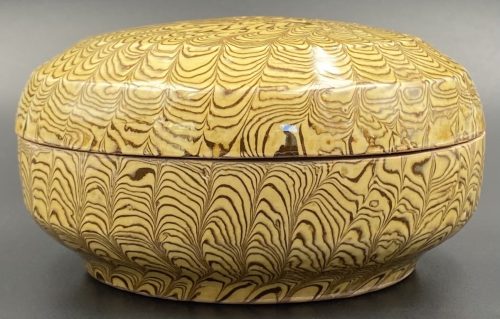 Press moulded round box with a cover made of yellow and brown marble clay, glazed with a clear glaze inside and outside. China, the Tang dynasty [唐朝] (618 – 907) Diameter: 11 cm; Height: 5.5 cm.
Press moulded round box with a cover made of yellow and brown marble clay, glazed with a clear glaze inside and outside. China, the Tang dynasty [唐朝] (618 – 907) Diameter: 11 cm; Height: 5.5 cm. -
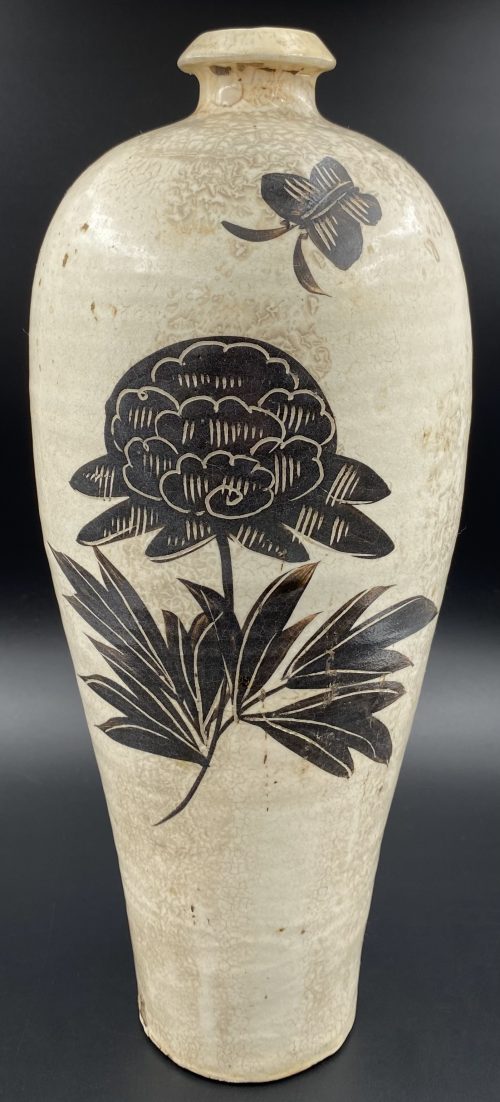 Typical meiping body, short neck, lipped rim; painted in the blackish-brown slip with two blossoms and butterflies under a clear glaze. The foot ring is unglazed exposing the brown body. China, the Yuan Dynasty [大元] (1279 – 1368). Diameter: 14 cm; Height: 30.5 cm.
Typical meiping body, short neck, lipped rim; painted in the blackish-brown slip with two blossoms and butterflies under a clear glaze. The foot ring is unglazed exposing the brown body. China, the Yuan Dynasty [大元] (1279 – 1368). Diameter: 14 cm; Height: 30.5 cm. -
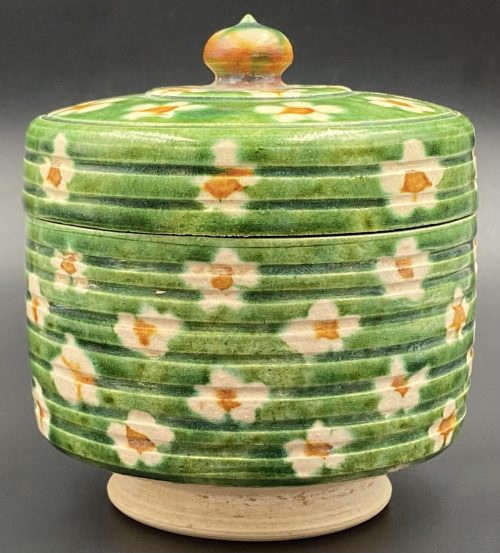 Green, mottled (white, yellow, brown) glazed earthenware jar or a circular box with a cover, on an unglazed foot decorated with florets. The cover has a small knop. Ivory glaze inside. China, the Tang dynasty [唐朝] (618 – 907). Diameter: 10 cm; Height: 10 cm.
Green, mottled (white, yellow, brown) glazed earthenware jar or a circular box with a cover, on an unglazed foot decorated with florets. The cover has a small knop. Ivory glaze inside. China, the Tang dynasty [唐朝] (618 – 907). Diameter: 10 cm; Height: 10 cm.


